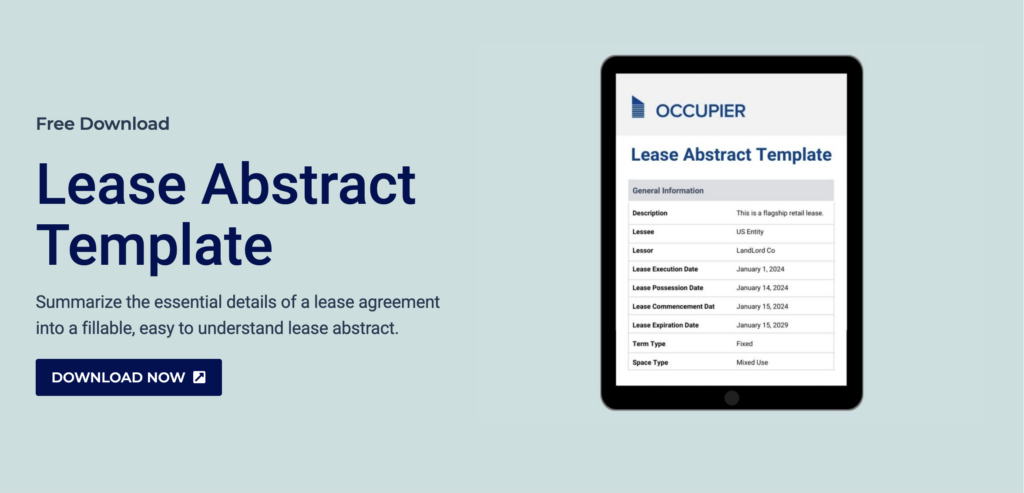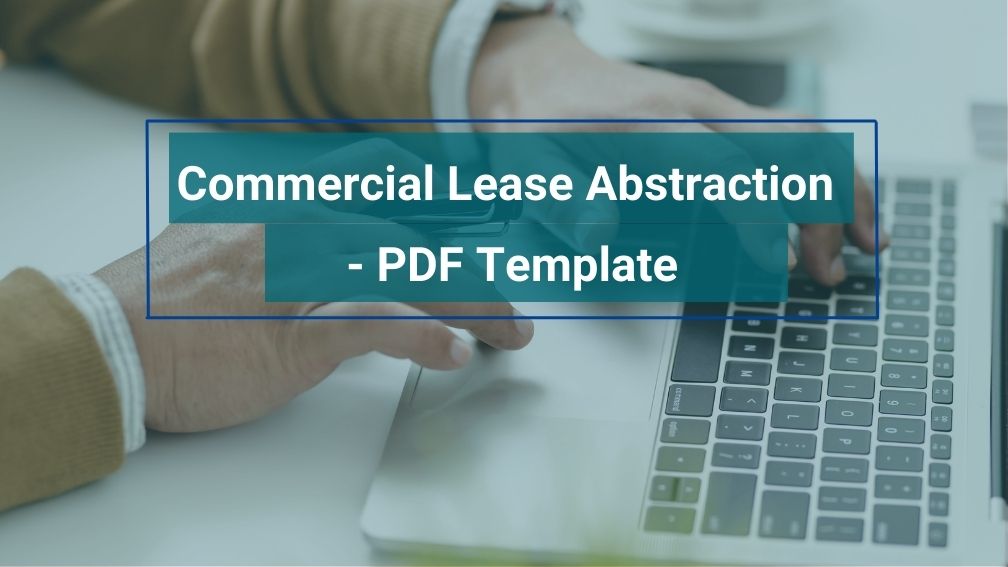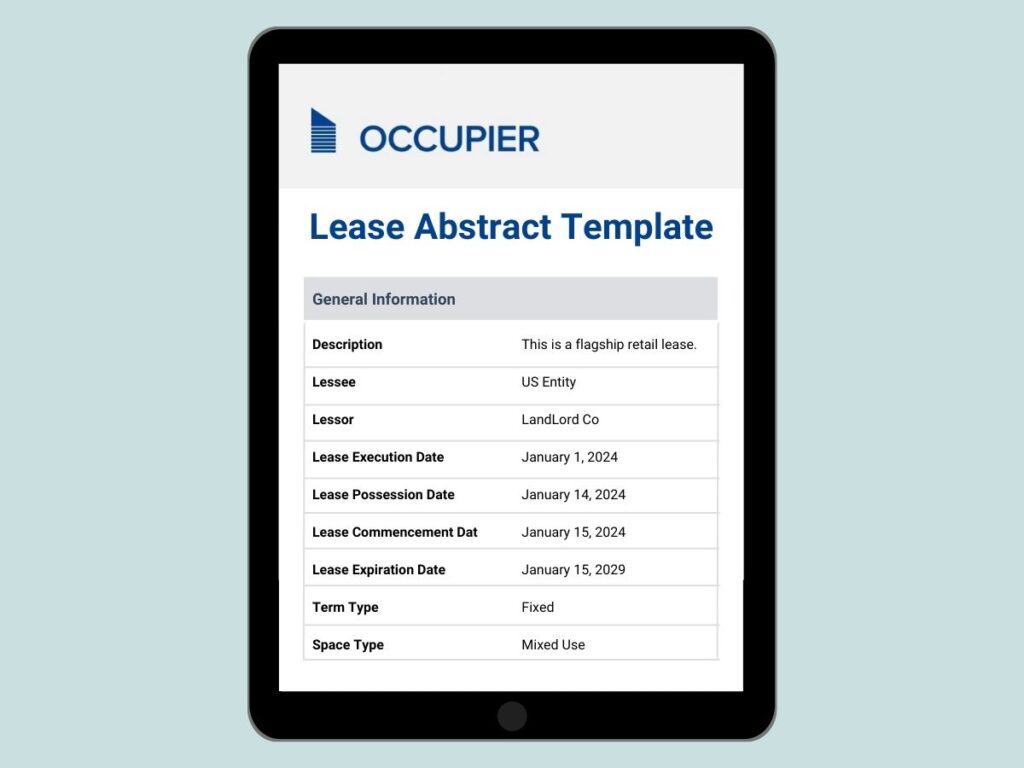Pillars of Commercial Lease Abstraction – Template
Last Updated on November 30, 2023 by Morgan Beard
Are you a commercial tenant looking to streamline your lease management process? Lease abstraction may be the solution you need. By summarizing the essential details of a lease agreement, lease abstraction can help you make informed decisions and improve your overall efficiency. We will outline the pillars of commercial lease abstraction and provide a downloadable abstract template — a comprehensive tool for optimizing the lease abstraction process.
Lease Abstraction Explained
What is lease abstraction? Lease abstraction is the process of summarizing the critical information in a lease agreement. The objective of lease abstraction is to present the lease in a concise and organized manner that highlights the essential details. This process involves reviewing and analyzing the lease agreement to extract important information such as lease term, rent, options, and critical dates. Transcribing your original lease documents via a due diligence process like lease abstraction ultimately helps the landlord-tenant relationship. How and why? Well, because important legal jargon and crucial data inputs are distilled down in a way that benefits both parties.
The Importance of Commercial Lease Abstraction
One of the key benefits of lease abstraction is that it reduces the likelihood of errors and disputes. Commercial leases are often complex documents, and without an organized and concise summary of the critical information, it can be easy to misinterpret or overlook key details. Lease abstraction ensures that all relevant information is captured, reducing the likelihood of errors that can result in costly disputes or legal challenges.
Another benefit of lease abstraction is that it facilitates better decision-making. By providing a clear and concise summary of the essential information contained in a lease agreement, landlords and tenants can make informed decisions about their properties or leases. For example, they can quickly determine when the lease will expire, whether rent increases are scheduled, or if there are any renewal options available.
Lease Abstract Automation
Occupier lease management software will automate the export of your portfolio’s lease abstract. Download our lease abstract PDF template to get started.
Pillars of Commercial Lease Abstract
By abstracting the essential information from a lease agreement, commercial real estate professionals can effectively manage their leases and properties, ultimately leading to a more successful and profitable real estate business. We will dive into the key pillars of data that should be included in your lease abstract documents.
Pillar 1: General Lease Information
The general lease information section is essential because it provides an overview of the lease agreement’s key terms and conditions. This information is critical for both landlords and tenants as it outlines the fundamental details of the agreement, enabling them to understand their respective obligations and responsibilities.
In addition to the basic details, the general lease information section should also include any restrictions or limitations on the use of the property, such as zoning restrictions or limitations on alterations to the space. Any additional provisions related to the use of the property, such as parking or access to common areas, should also be included in this section.
It’s worth noting that the general lease information section is just one part of the overall lease abstraction process. While this section provides a basic overview of the lease agreement, the other pillars of commercial lease abstraction provide more detailed information about the financial and legal aspects of the lease.
Pillar 2: Financial Information
The financial information section is a crucial part of the commercial lease abstraction process, as it provides an overview of the financial terms and conditions of the lease agreement. This section of the abstract template should include all financial details that relate to the lease, including rent escalation, operating expenses, and common area maintenance fees, aka CAM fees.
In addition to the basic financial information, the section should also include information on any rent abatements, concessions, and allowances. This information is important as it can impact the financial health of the property and the overall lease agreement. For example, rent abatements can provide temporary relief to tenants who are facing financial difficulties, while concessions and allowances can be used to incentivize tenants to sign long-term leases or to make improvements to the property.
Pillar 3: Lease Amendments
The lease amendments section is important because it provides a summary of any changes that have been made to the original lease agreement. By capturing this information in the abstract, commercial real estate professionals can quickly and easily identify any modifications that have been made to the lease agreement, enabling them to understand the current status of the lease.
In addition to lease renewals, extensions, and options, the lease amendments section should also include any changes to the rental rate, security deposit, or any other financial terms. Any modifications to the use of the property or alterations to the space should also be included in this section.
Not only is this beneficial to your lease administrators but your lease accounting team will want to see and track any lease amendments as it results in a lease modification under ASC 842. If lease amendments are not recorded and tracked properly, then it can result in inaccuracies in your accounting team’s journal entries under ASC 842 and ultimately impact your audit.
Pillar 4: Critical Dates
The critical dates section is an essential component of commercial lease abstraction. This section of the abstract template should include all important dates related to the lease, including the lease start date, expiration date, and option dates like expansion rights.
In addition to these key dates, this section should also outline the impact or risk analysis associated with the critical date. For example, it should include rent increases and any associated notice periods. It should also include any renewal deadlines or termination notice periods, as failing to meet these dates can result in the lease being automatically renewed or terminated.
By including all critical dates in the abstract template, commercial real estate professionals can ensure that they stay informed and on top of important deadlines. This can help to prevent misunderstandings or disputes between landlords and tenants and can help to avoid legal issues that can arise from missed deadlines. Missing a critical date causes massive headaches for commercial tenants on top of insane expenses.
Pillar 5: Clauses
The clauses section of the abstract template is an important part of commercial lease abstraction that should not be overlooked. This section should include any relevant lease clauses that could impact either the landlord or tenant. These clauses can range from the mundane to the complex, but all of them have the potential to impact the lease.
Some common clauses that should be included in the abstract template are related to insurance, maintenance, repair, alterations or exclusive use clauses. Insurance clauses may outline the type and amount of insurance coverage required by the landlord or tenant, while maintenance clauses may detail who is responsible for maintaining different parts of the property. Repair clauses may specify the party responsible for making repairs, while alteration clauses may outline the process for making changes to the leased space.
Your facility teams and onsite retail or office teams will appreciate having a quick repository of maintenance clauses so they can quickly understand if the tenant or landlord is responsible for repairs. By including all relevant clauses in the abstract template, commercial real estate professionals can ensure that all parties have a clear understanding of their obligations and rights under the lease. This can help to prevent misunderstandings or disputes between landlords and tenants and can help to avoid legal issues that can arise from breaches of lease clauses.
Pillar 6: Custom Data
The custom data section of the abstract template is an important part of commercial lease abstraction that can help capture any additional information that is specific to the lease agreement. This section is designed to be flexible, and captures the unique lease data or provisions that are especially important to your organization.
This particular section captures leasing data that does not cleanly fit into the first 5 pillars of the lease abstract. For example, if the leased property has any unique features, such as a special parking arrangement, the custom data section is where you would document it. If the lease agreement has any specific use restrictions or special provisions, such as hours of operation or noise restrictions, it is important to document those in the custom data section.
In addition, this section can also be used to capture any additional financial details that are not covered in the financial information section, such as incentives or revenue-sharing arrangements. It is essential to document all the details about any custom data related to the lease to ensure that everyone involved in the lease agreement has a clear understanding of the expectations and obligation.
Lease Abstract – Downloadable Form Fill Template:
As a commercial tenant, having lease abstracts for your real estate leases sets you up to make strategic decisions based on financial analysis. Pertinent business and legal information is embedded in your real estate lease portfolio. By abstracting that critical lease data, all the essential elements of your retail property or office property lease are at your fingertips — including insights like rent provisions, security deposit information, cash flow health.
Our Lease Abstract – Downloadable PDF Template is a comprehensive tool designed to help commercial real estate professionals abstract important lease details efficiently and accurately. The template is organized into six pillars, including general lease information, financial information, lease amendments, critical dates, clauses, and custom data.

This template includes a customizable format that allows for flexibility, ensuring that all the essential details of the lease agreement are captured accurately. Each section of the template is designed to capture specific lease details, such as the parties involved, property address, rental rates, rentable square footage, security deposits, rent escalation, operating expenses, common area maintenance fees, renewal options, and critical dates.
Occupier is purpose built from the perspective of the commercial tenant, enabling real estate teams and lease accounting teams to collaborate on the entire leasing process. We know that lease abstracts are important documents to distill your long lease contracts into digestible data points. So, with our lease management software you can export your lease data via automated lease abstraction to share with your tenant-rep brokers, legal teams and facilities teams. Schedule a demo to see how Occupier real estate software powers your strategic decisions.
Lease Accounting Resources
Check out our resource hub. We have the templates, spreadsheets, and calculators to help you manage entire lease lifecycle.

